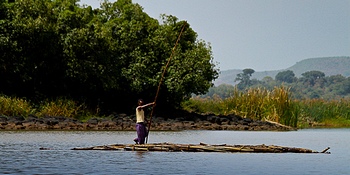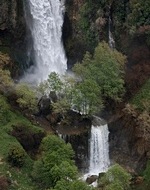
The theme of this year’s World Water Week was “Water Cooperation: Building Partnerships”. SEI hosted an event on the water-energy-food “nexus” and participated in several others. Annette Huber-Lee and Holger Hoff, two senior researchers who play key roles in SEI’s nexus work, answered questions about the nexus framework, why it’s needed, and how SEI is applying it to address real-world problems.
Q: Why are partnerships – across sectors, across borders – so important in the water sector?
HH: Water problems in an increasingly interconnected world can no longer be solved by water experts only – they probably they never could, but many systems are at the limit now, which they weren’t before. It goes both ways: water underpins other food, energy and environmental security, while pressures originating in other sectors/spheres – e.g. climate change, land-use change and land degradation, pollution – determine water availability, its quality and productivity. A key element of these partnerships has to be capacity-building and tool development to enable partners in their respective sectors to understand, assess and address externalities in the other sectors.

AHL: The history of planning and management in the water, food and energy sectors is one of silos: planning without consideration of the impacts and possible co-benefits of joint planning. This is deeply rooted even in how professionals in these sectors are trained – agricultural, electrical and civil engineers (and economists) take courses and specialize in narrow fields of analysis. Unless there are at the very least opportunities for joint discussions across these sectors, we will continue to see serious consequences.
Q: SEI’s work is actively building such partnerships. What are some examples?
HH: In the Blue Nile basin, in Ethiopia, we are facilitating and supporting a dialogue among partners – government, NGOs and scientific institutions – from the water, land, agriculture and environmental sectors. Together we are developing scenarios of future trends that are to be tested with our nexus tools: SEI’s Water Evaluation and Planning (WEAP) and Long-range Energy Alternatives Planning (LEAP) systems, and the Global Agro-ecological Zones (GAEZ) system from the UN Food and Agriculture Organization.
We’ve done similar work in the Middle East and North Africa region, where climate adaptation and mitigation need to be addressed together. The Adaptation to Climate Change in the Water Sector in the MENA Region Programme (ACCWaM) in which we’re involved is now piloting nexus projects in true partnerships. The climate strategy of Jordan, where we have worked for the past 10 years, also reflects a nexus approach.
AHL: We have also been actively working across the U.S., especially in California and the Southwest. Early results show the tremendous advantage of improved efficiency across all three sectors: water (especially in the urban areas), agriculture and food. There are clear economics gains from such gains in efficiency, but few incentives to motivate such change. Without these, more radical policies will be needed to shift water from what the public perceives to be a higher priority sector – most likely urban use.

Q: How does the nexus framework help with these kinds of analyses?
HH: The nexus framework picks up components from other existing integrated approaches, such as ecosystem approaches, landscape approaches, integrated water resources management, multi-functional systems, etc. It fosters new types of partnerships by not starting from any particular sector – like Integrated Water Resources Management (IWRM) does – but instead defining research questions and management strategies with all relevant sectors involved. It is valuable by making explicit (quantitative) the costs or tradeoffs of not cooperating and the benefits of cooperating
AHL: The nexus approach levels the playing field by having policy-makers and stakeholders from the various sectors sit at the table with equal status. It allows each sector to articulate their priorities, key uncertainties and measures of success. A combination of qualitative and quantitative approaches can demonstrate the advantages and disadvantage of different strategies, especially those that are single-sector-focused. Policy-makers and stakeholders can actually see the gains from cooperative approaches.
Q: How is SEI approaching the nexus? What are your priorities in this regard?
HH: SEI provides context-specific data, information and knowledge, the evidence base for a nexus approach, starting from stakeholder interactions for defining key issues or problems to be addressed, which couldn’t be solved yet by conventional sectoral approaches. The long-term goal is to build a knowledge base of nexus case studies in various regions, synthesizing success factors and conditions for replication and upscaling.
Design and development by Soapbox.
